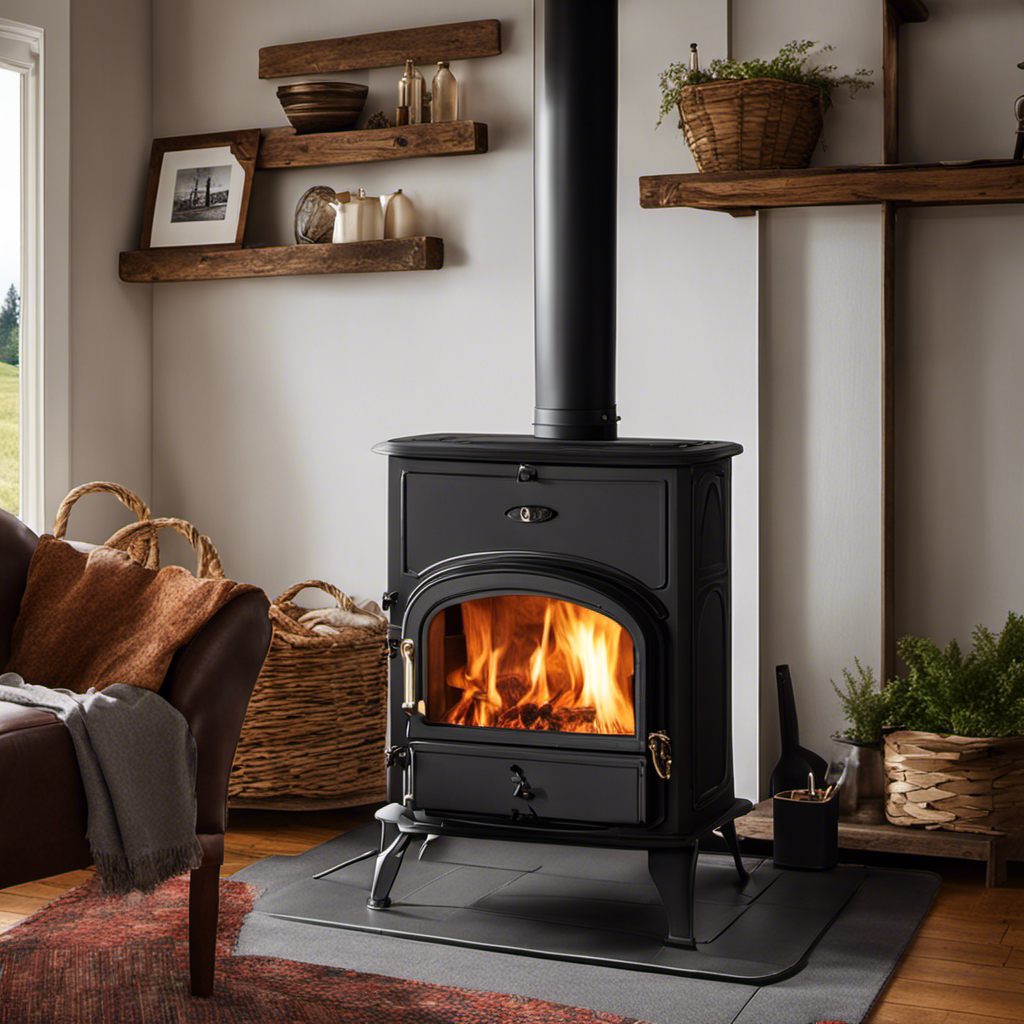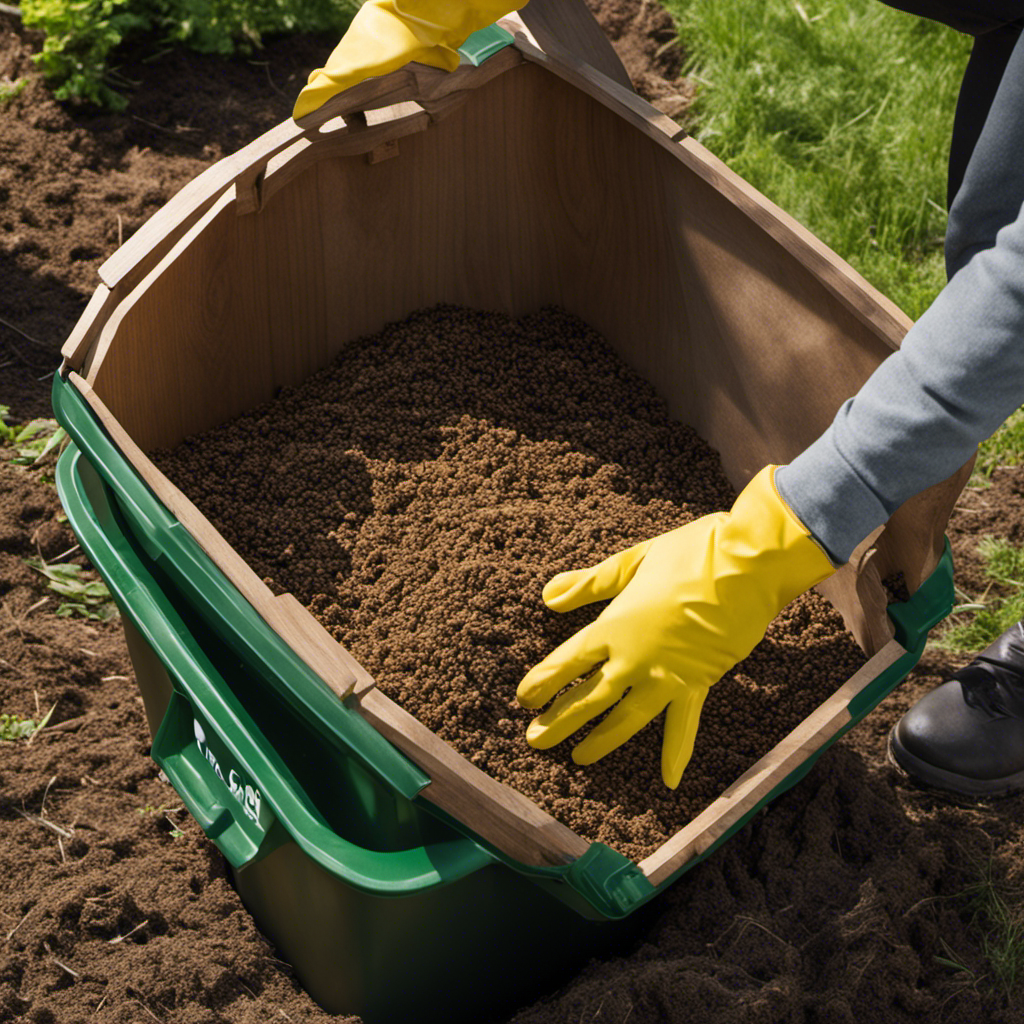Upon entering the cozy warmth of my home, I’m greeted by the soothing crackling sounds and the gentle warmth radiating from my wood pellet stove.
In this article, I’ll guide you through the ins and outs of using a wood pellet stove to keep your space toasty and your energy bills down.
From understanding the basics to troubleshooting common issues, I’ll provide you with the technical know-how to make the most of this efficient heating option.
Let’s dive in and harness the power of wood pellets!
Key Takeaways
- Wood pellet stoves burn compressed wood pellets for heat and are eco-friendly.
- Choosing high-quality wood pellets with low moisture content and minimal dust is important for efficient operation.
- Different pellet sizes and types, such as hardwood pellets, can affect burn time and heat production.
- Proper loading, lighting, temperature adjustment, and regular cleaning and maintenance are essential for safe and efficient use of wood pellet stoves.
Understanding the Basics of a Wood Pellet Stove
To start using a wood pellet stove, you’ll need to understand the basics of how it works. A wood pellet stove is a heating appliance that burns compressed wood pellets to generate heat. These pellets are made from recycled wood waste, making them an eco-friendly option. The stove consists of a hopper where the pellets are placed, an auger that feeds the pellets into the combustion chamber, and a fan that blows air into the chamber to ignite and sustain the fire.
Regular wood pellet stove maintenance is crucial to ensure its efficient operation. This includes cleaning the stove, inspecting and replacing any worn-out parts, and checking the chimney for blockages. The benefits of using a wood pellet stove include cost savings, reduced carbon emissions, and the ability to control the temperature easily.
Now that you understand the basics of a wood pellet stove, let’s move on to choosing the right wood pellets for your stove.
Choosing the Right Wood Pellets for Your Stove
When it comes to choosing the right wood pellets for your stove, two key factors to consider are pellet quality and efficiency.
Pellet quality refers to the overall consistency and durability of the pellets, which can greatly impact their performance and burn efficiency.
Additionally, the type of wood used to make the pellets can also affect their performance, with hardwood pellets typically offering a longer burn time and higher heat output compared to softwood pellets.
Pellet Quality and Efficiency
You can improve the efficiency of your wood pellet stove by ensuring the quality of the pellets you use. Here are some key factors to consider:
-
Pellet Storage: Proper storage is crucial to maintain pellet quality. Store them in a dry area, away from moisture and pests.
-
Ash Disposal: Regularly clean out the ash from your stove to prevent build-up, which can decrease efficiency.
-
Pellet Size: Choose pellets that are consistent in size, as this allows for better combustion and less ash production.
-
Low Moisture Content: Opt for pellets with low moisture content, as higher moisture levels can decrease heat output and cause more ash.
-
Minimal Dust: Look for pellets that have minimal dust, as excessive dust can clog the stove’s burn pot and reduce efficiency.
By following these guidelines, you can ensure that the pellets you use will maximize the efficiency of your wood pellet stove.
Now, let’s explore the different types of wood pellets available.
Types of Wood Pellets
There are various types of wood pellets available that differ in composition and quality. When it comes to wood pellets, size matters. Different pellet sizes can affect the efficiency and performance of your wood pellet stove.
Smaller pellets tend to burn faster and produce more heat, while larger pellets burn slower and provide a longer burn time. Additionally, the composition of the wood pellets can make a significant difference in their performance.
Hardwood pellets, for example, are known for their higher energy density and lower ash content compared to softwood pellets. This makes hardwood pellets more efficient and cleaner burning, resulting in less maintenance and improved air quality.
Proper ventilation and airflow for efficient burning is crucial for maintaining optimal performance in your wood pellet stove. By ensuring adequate ventilation, you can maximize the combustion process and achieve optimal heat output.
Proper Ventilation and Airflow for Efficient Burning
To ensure efficient burning, it is important to make sure your wood pellet stove has proper ventilation and airflow. Here are some ventilation tips that can help improve burning efficiency:
-
Clean the air intake regularly to remove any dust or debris. This will ensure a steady flow of fresh air into the stove.
-
Check the exhaust system to make sure there are no blockages, such as soot or creosote buildup, in the exhaust pipe or chimney.
-
Use the damper correctly to control the amount of air entering the stove. This will allow for optimal combustion.
-
Position the stove properly in a well-ventilated area. Make sure there is enough space around the stove to allow for proper airflow.
-
Consider connecting your stove to an external air supply, if possible. This can help minimize the amount of indoor air used during combustion.
Loading and Lighting the Wood Pellet Stove
Once you’ve properly loaded and lit your wood pellet stove, sit back and enjoy the cozy warmth it provides. Loading techniques are crucial for efficient and safe operation. Make sure to follow these steps:
-
Clear the burn pot: Remove any ash or debris from the burn pot before adding new pellets. This ensures proper airflow and combustion.
-
Fill the hopper: Use high-quality wood pellets and fill the hopper to the recommended level. Avoid overfilling to prevent jams and excessive ash buildup.
-
Start the ignition process: Depending on your stove model, follow the manufacturer’s instructions to ignite the pellets. This may involve pressing a button or using a match.
Troubleshooting tips:
- If the pellets don’t ignite, check for blockages in the fuel delivery system or try cleaning the igniter.
- Inconsistent or weak flame can indicate improper pellet feeding or airflow issues. Adjust the settings accordingly.
By mastering the loading techniques and troubleshooting tips, you can ensure optimal performance from your wood pellet stove.
Now, let’s move on to adjusting the temperature and heat output for personalized comfort.
Adjusting the Temperature and Heat Output
Now that you’ve mastered loading and lighting, it’s time to adjust the temperature and heat output of your wood pellet stove for personalized comfort. To ensure optimal heating performance, follow these steps:
- Start by locating the thermostat settings on your wood pellet stove.
- Use the thermostat knob or buttons to increase or decrease the desired temperature.
- Monitor the heat levels by observing the digital display or gauge on the stove.
- Fine-tune the heat output by adjusting the air intake or exhaust damper.
- For precise control, refer to the manufacturer’s instructions for specific adjustments.
By adjusting the thermostat settings and controlling heat levels, you can create a cozy environment that suits your preferences.
Now, let’s move on to cleaning and maintaining your wood pellet stove, ensuring its longevity and efficiency.
Cleaning and Maintaining Your Wood Pellet Stove
To clean and maintain your wood pellet stove, it’s important to regularly remove ash buildup from the firebox and clean the glass door for optimal performance. When it comes to cleaning tools, a metal scoop or ash vacuum can be used to safely remove the ash from the firebox. Make sure to wear gloves and a dust mask for protection.
Cleaning the glass door can be done using a non-abrasive glass cleaner and a soft cloth. It’s recommended to clean the glass after every 2-3 bags of pellets burned to prevent stubborn buildup.
In terms of frequency of maintenance, it’s best to clean the firebox and glass door at least once a week during the heating season. Regular cleaning will not only improve the efficiency of your stove but also prolong its lifespan.
Now, let’s move on to troubleshooting common issues with wood pellet stoves.
Troubleshooting Common Issues With Wood Pellet Stoves
If you’re experiencing issues with your wood pellet stove, a common troubleshooting step is to check for any blockages in the exhaust vent. This can cause poor airflow and prevent the stove from functioning properly.
However, there are other common issues that may arise with pellet stoves, such as a malfunctioning igniter or a jammed auger. Here are some tips to troubleshoot these problems:
-
Ensure that the igniter is clean and in good condition.
-
Check the wiring connections to the igniter and ensure they are secure.
-
If the igniter is not working, it may need to be replaced.
-
If the auger is jammed, first turn off the stove and unplug it.
-
Carefully remove any pellets or debris that may be causing the jam.
By following these troubleshooting steps, you can address common issues with your wood pellet stove and get it back up and running efficiently.
However, it is important to remember safety precautions and best practices to ensure the proper operation and maintenance of your pellet stove.
Safety Precautions and Best Practices
When operating a wood pellet stove, it’s important to follow safety precautions and best practices to ensure proper maintenance and operation.
Fire prevention is crucial, so be sure to keep the area around the stove clear of any flammable materials. Regularly clean out the ash and debris from the stove to prevent buildup, which can increase the risk of a fire.
Additionally, it’s essential to have carbon monoxide detection in place to ensure your safety. Install a carbon monoxide detector near the stove and regularly check its batteries to ensure it’s functioning properly. Remember, carbon monoxide is a colorless and odorless gas that can be deadly if not detected.
By following these safety precautions and best practices, you can enjoy the warmth and comfort of your wood pellet stove while ensuring the safety of your home.
Now, let’s explore how to maximize energy efficiency and cost savings with your wood pellet stove.
Maximizing Energy Efficiency and Cost Savings With Your Wood Pellet Stove
When it comes to maximizing energy efficiency and cost savings with your wood pellet stove, two key factors to consider are optimal temperature settings and proper maintenance techniques.
Finding the right temperature setting is crucial in order to achieve a balance between comfort and energy consumption.
Additionally, regularly maintaining your stove by cleaning the combustion chamber, inspecting the exhaust system, and ensuring proper air flow will not only improve its performance but also extend its lifespan.
Optimal Temperature Settings
To achieve optimal temperature settings, it’s important to adjust the airflow and fuel settings accordingly. Here are some key considerations to keep in mind:
- Ensure proper air intake to allow for efficient combustion.
- Adjust the fuel feed rate to control the heat output.
- Monitor the stove’s temperature gauge to maintain a consistent temperature.
- Regularly clean the stove’s burn pot to prevent clogs and ensure proper fuel combustion.
- Use high-quality wood pellets to maximize fuel efficiency and reduce emissions.
By fine-tuning these settings, you can achieve optimal fuel consumption and adjust the heat output of your wood pellet stove to meet your specific heating needs.
Now, let’s move on to discussing proper maintenance techniques to keep your stove running smoothly and efficiently.
Proper Maintenance Techniques
Make sure you regularly clean and inspect the burn pot to prevent clogs and ensure efficient operation.
The burn pot is a crucial component of a wood pellet stove and can easily become clogged with ash and debris over time.
To clean the burn pot, first, make sure the stove is cool and the power is turned off. Then, remove the burn pot and empty any ash or debris. Use a wire brush to scrub away any stubborn residue.
Inspect the burn pot for any signs of damage or wear, such as cracks or holes. If you notice any issues, it is important to replace the burn pot to avoid further problems.
Regular maintenance of the burn pot will help prevent common problems such as inefficient burning and poor heat output.
Frequently Asked Questions
Can I Use Regular Firewood Instead of Wood Pellets in My Wood Pellet Stove?
I can use regular firewood instead of wood pellets in my wood pellet stove, but there are pros and cons. Firewood requires more frequent refueling, produces more ash, and may not burn as efficiently as wood pellets.
How Often Do I Need to Clean the Chimney of My Wood Pellet Stove?
Cleaning the chimney of my wood pellet stove is an essential maintenance task. It ensures proper airflow and prevents the buildup of dangerous creosote. Regular cleaning, typically once a year, keeps the stove operating efficiently and reduces the risk of chimney fires.
Can I Leave My Wood Pellet Stove Unattended While It Is Running?
Yes, you can leave your wood pellet stove unattended while it’s running, but it’s important to take safety precautions. Ensure proper ventilation, keep flammable objects away, and install a carbon monoxide detector for added safety.
What Should I Do if My Wood Pellet Stove Is Not Producing Enough Heat?
If my wood pellet stove is not producing enough heat, I would troubleshoot by checking the fuel supply, air intake, and exhaust vent. If the issue persists, I would consider using alternative heat sources.
Are There Any Specific Safety Precautions I Need to Take When Using a Wood Pellet Stove?
When using a wood pellet stove, it’s important to follow safety tips and perform regular maintenance. Safety precautions include keeping flammable materials away, ensuring proper ventilation, and cleaning the stove regularly. Maintenance tips include cleaning the ash pan, checking the hopper, and inspecting the burn pot.
What Is the Best Way to Use a Wood Pellet Stove Compared to a Traditional Wood Stove?
When considering the best way to use a wood vs pellet stoves, it’s important to note that wood pellet stoves are typically more efficient and cleaner than traditional wood stoves. Pellet stoves require less maintenance and produce less ash, making them a more convenient option for heating your home.
Conclusion
In conclusion, using a wood pellet stove can be a convenient and efficient way to heat your home. By understanding the basics of how the stove works and choosing the right pellets, you can ensure optimal performance.
Proper ventilation and airflow are crucial for efficient burning, while loading and lighting the stove correctly will help maintain a steady heat output. Regular cleaning and maintenance will extend the lifespan of your stove.
Remember to follow safety precautions and best practices for a worry-free experience. And don’t forget, with a wood pellet stove, you can ‘turn up the heat’ without burning a hole in your wallet!
Logan’s affair with adventure began in childhood. He hailed from a small town where vast forests bordered one side and endless shores stretched on the other. His days were spent exploring uncharted woods, climbing tall trees, or listening to the tales of old sailors. This early immersion in a world brimming with stories and mysteries became the foundation of his passion for writing.












